Made in Space: Startup creates drug ingredients in low Earth orbit to make medicines ‘purer’ and cheaper
A space capsule containing a small, unmanned pharmaceutical factory floated into the Utah desert in February with freshly made crystals of HIV medication.
The orbital platform was the result of four years of work by a new company based in California, Varda, which hopes to use the unique conditions of microgravity in low Earth orbit to produce purer and therefore cheaper drugs.
Just like the strange shapes that ice cubes can take in an out-of-balance ice cube tray, a drug company’s tiny chemical reactions on a molecular scale can lead to crooked, unwanted shapes just as a result of Earth’s gravity.
But Varda isn’t the only company joining Big Pharma’s space race in an effort to improve these conditions for creating their crystalline drug molecules.
Drug giant Eli Lilly and a host of universities working with the International Space Station’s National Lab have also begun testing orbital platforms for everything from cancer drugs to Alzheimer’s disease research.
A space capsule containing a small, unmanned pharmaceutical factory (above) floated into the Utah desert in February carrying freshly made crystals of HIV medication
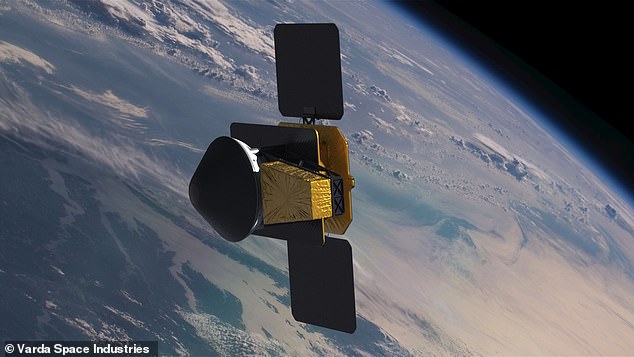
The orbital platform was the result of four years of work by a new company based in El Segundo, California, Varda Space Industries, which hopes to use the unique conditions of microgravity in low Earth orbit to produce purer and therefore cheaper drugs.
“The impact of microgravity appears to be very effective in obtaining pure crystalline materials with unique properties,” says biochemistry professor Anne Wilson of Butler University. the Wall Street Journal this week.
Wilson – who has researched the crystallization chemistry of microgravity but has no direct ties to Varda – noted that the promise of microgravity holds improved molecular structures for a wide range of specialty materials, both inside and outside medicine.
Varda is currently analyzing the results of its test of HIV drug production in space, the company’s Chief Science Officer Adrian Radocea said.
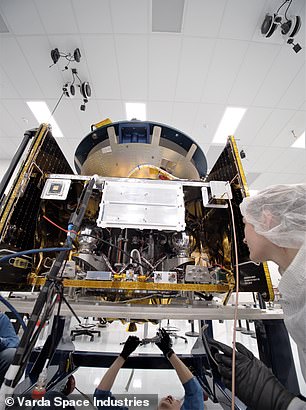
Varda is now preparing for two future flights, which will launch this year from June or July aboard a reusable SpaceX rocket, according to Varda co-founder and president Delian Asparouhov.
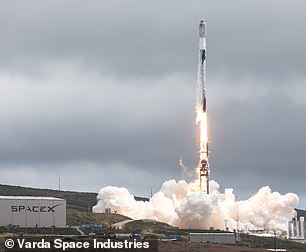
Asparouhov said his company has already signed contracts with pharmaceutical companies for this year’s flights, as well as three more contracts for 2025, some of whose names will be announced before this summer’s launch.
The project, which manufactured the drug ritonavir, started in June 2023.
The company is now preparing for two future flights, which will launch this year from June or July aboard a reusable SpaceX rocket, according to Varda’s co-founder and president Delian Asparouhov.
Asparouhov told the Journal that his company has already signed contracts with pharmaceutical companies for this year’s flights, as well as three more contracts for 2025 – some names of which will be announced before this summer’s launch.
But the space medicine startup also has a more terrestrial program to help pharmaceutical companies determine whether their drugs would especially benefit from the extensive process of microgravity production in orbit.
A new article by two researchers for Varda, published Thursday in the journal Crystal growth and designused a ground-based centrifuge to track which crystalline structured drug molecules are most sensitive to gravitational forces.
The company’s scientists called the proof of concept a “hypergravity crystallization platform,” which they plan to offer to potential pharmaceutical customers as a useful screening tool for how their own drugs respond to gravity.
For their peer-reviewed test, Varda researcher Kanjakha Pal and his CSO Radocea used the essential amino acid L-histidine, which has unique properties based on its shape and has been used to preserving organs prior to transplant operations.
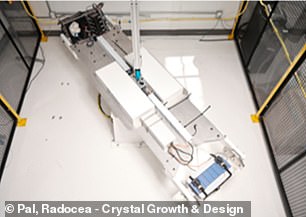
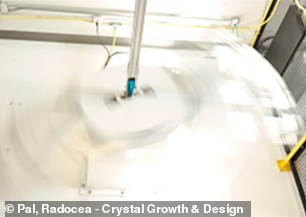
A new paper by two researchers for Varda, published Thursday in the journal Crystal Growth & Design, used a ground-based centrifuge (above) to track which crystalline structured drug molecules are most sensitive to gravity.
“The hypergravity experiments,” wrote Pal and Radocea, “show that gravity influences the crystallization process even when the solution is stirred at high speed (in a centrifuge).”
According to them, the result emphasized ‘that gravity probably plays an important role in many crystallization processes of small molecules.’
“If you can observe a trend, it is much easier to convince a scientific audience,” Radocea told the Journal.
Varda’s researchers hope to conduct further experiments to differentiate what other factors, such as cosmic rays, may influence chemical reactions in low Earth orbit.
“Ideally,” as Varda’s co-founder and investor Josh Wolfe put it, “this reduces the cost of very expensive, life-saving drugs.”

